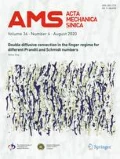Abstract
The Finite Element Method of Lines (FEMOL) is a semi-analytic approach and takes a position between FEM and analytic methods. First, FEMOL in Fracture Mechanics is presented in detail. Then, the method is applied to a set of examples such as edge-crack plate, the central-crack plate, the plate with cracks emanating from a hole under tensile or under combination loads of tensile and bending. Their dimensionless stress distribution, the stress intensify factor (SIF) and crack opening displacement (COD) are obtained, and comparison with known solutions by other methods are reported. It is found that a good accuracy is achieved by FEMOL. The method is successfully modified to remarkably increase the accuracy and reduce convergence difficulties. So it is a very useful and new tool in studying fracture mechanics problems.
Similar content being viewed by others
References
Hu, S.W.: Torsional analysis of composite steel-concrete beams with cracks. [Ph.D. thesis], Beijing: Tsinghua University, 1999.11 (in Chinese)
Yuan, S.: The Finite Element Method of Lines–-Theory and Applications. Science Press, Beijing, 1994
Williams, M.L.: Stress singularities resulting from various boundary conditions in angular corners of plates in extension. J. Appl. Mech. 19(4), 526–528 (1952)
Malik, S.N.: Elastic-plastic analysis for a finite thickness rectangular plate containing a through central crack. J. Frac. 18(1), 28–36 (1982)
Anderson, A.L.: Fracture Mechanics—Fundamentals and Applications. Second Edition, CRC Press, 1995
Gyekenyesi, J.P., Mendelson, A.: Three-dimensional elastic stress and displacement analysis of finite geometry solids containing cracks. Int. J. Frac. 11, 409–429 (1975)
Gladwell, G.M.L., Fan, T.Y.: Galin's theorem holds for a moving punch. Acta Mech. Sinica 7(2), 165–171 (1991)
Zhang, T.Y., et al: Fracture mechanics for mode II crack in a piezoelectric material. Int. J. Solids Struct. 33, 343–359 (1996)
Liu, D.K., Lin, H.: Scattering of sh-waves by an interacting interface linear crack and a circular cavity near bimaterial interface. Acta Mech. Sinica 20(3), 317–326 (2004)
Xia, S., Wang, T.C., Chen, S.H.: Crack tip field and J-integral with strain gradient effect. Acta Mech. Sinica 20(3), 228–237 (2004)
Chen, S.H., Wang, T.C., Kao-Walter, S.: Finite boundary effects in problem of a crack perpendicular to and terminating at bimaterial interface. Acta Mech. Sinica 21(1), 56–64 (2005)
Fang, Q.H., Liu, Y.W., Jiang, C.P.: Interaction between a screw dislocation and an elastic elliptical inhomogeneity with interfacial cracks. Acta Mech. Sinica 21(2), 151–159 (2005)
Author information
Authors and Affiliations
Corresponding author
Additional information
The English text was polished by Yunming Chen.
Rights and permissions
About this article
Cite this article
Hu, S., Moran, B. Cracking analysis of fracture mechanics by the finite element method of lines (FEMOL). ACTA MECH SINICA 21, 495–502 (2005). https://doi.org/10.1007/s10409-005-0059-1
Received:
Revised:
Accepted:
Published:
Issue Date:
DOI: https://doi.org/10.1007/s10409-005-0059-1




